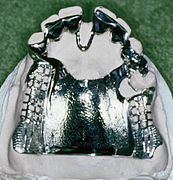Medial diastema
Diastema mediale (from ancient Greek διάστημα diástēma "space") or Margo interalveolaris (from Latin : margo "edge", inter "between" and alveolus "hollow") is called in dentistry the gap between the central incisors , which are mostly in the upper jaw , occurs more rarely in the lower jaw . The incisor gap is also called trema (from ancient Greek τρῆμα trēma "hole").
Real diastema
The real diastema is hereditary. It is characterized by a deeply ansetzendes frenulum to the inside of upper and lower lip (frenulum labii superioris or inferioris) from. The diastema can be removed through plastic surgery of the lip frenulum or the surgical removal of the tissue between the teeth by an oral, maxillofacial or facial surgeon and subsequent orthodontic measures. The most sensible time for treatment is before the permanent lateral incisors erupt, i.e. around the age of 6 to 8 years.
A pronounced diastema is very common in Africans and African-Americans. However, in these groups it is often viewed as a beauty feature. Some people who do not have a diastema try to create one artificially through cosmetic dentistry . The fabrication of a bridge in the upper anterior region in which a diastema should be seen presents major problems. An invisible connection bracket can be made on the palate for this purpose.
In addition to the lip frenulum, a mesiode (an excess central incisor, which is usually very small and cone-shaped) can also be the cause of the diastema in rare cases .
False diastema
The cause here is a failure or stunting of one or both of the lateral incisors. The treatment is carried out by widening the central incisors with composite material, veneers (veneer-like veneers), crowns or an all-ceramic bridge .
Medial diastema
The gap between the central upper incisors is caused by a dental arch that is too large and / or incisors that are too small, or by a lip frenulum that is too deep. The treatment corresponds to that of the false diastema.
Therapy options
A diastema can be closed with veneers, tooth crowns or composite abutments if the affected person is disturbed by the diastema, whereby the front teeth have to be widened. One method in which the teeth themselves do not have to be changed is orthodontic treatment . To do this, the teeth are moved using the multiband or aligner technique until the diastema is closed.
See also
- Tooth scheme
- Assessment standard for dental services, BEMA no. 61 (slide)
- Kaveggia syndrome
- Diastema (zoology)
Web links
Individual evidence
- ↑ a b Wilhelm Gemoll: Greek-German school and manual dictionary. Munich / Vienna 1965.
- ↑ Der kleine Stowasser : Latin-German school dictionary
- ↑ Hubertus JM van Waes, Paul W. Stöckli: Color Atlas of Dentistry 17 - Pediatric Dentistry, Thieme 2001 Online
- ^ Rudolf Walter Ott, Axel Bumann: Clinic and Practice Guide Dentistry, p. 358 Online





